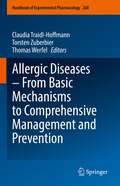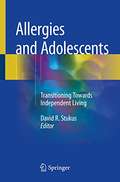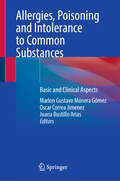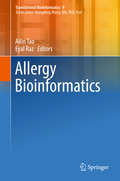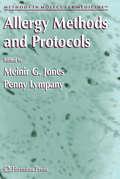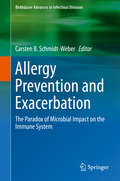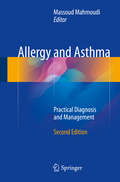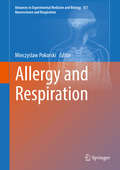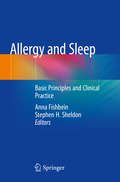- Table View
- List View
Allergic Diseases – From Basic Mechanisms to Comprehensive Management and Prevention (Handbook of Experimental Pharmacology #268)
by Torsten Zuberbier Thomas Werfel Claudia Traidl-HoffmannAllergy is the most frequent chronic disease in the 21st century having severe negative effects on health and the economy. The challenge we therefore face in medicine and science incorporates all areas of society – from politics to food industry, from schools to city planning, and many more. This volume informs the reader about continuously ongoing developments in allergy research and their implications for society. The chapter sections cover the immunological mechanisms in allergy on a molecular level, describe the triggers and cures for allergy in detail, entail clinical translation of lab findings on allergens, evaluate diagnostics for allergy markers, and provide solutions for future medical intervention or preventive strategies. Laboratory research, bioinformatics, climate modelling, patient treatment, intervention studies, epigenetics and multiple other disciplines are able to shed new light on this revolutionary field of healthcare.
Allergic Intimacies: Food, Disability, Desire, and Risk
by Michael GillThe first book to explore food allergies in the United States from the perspective of disability and raceAre food allergies disabilities? What structures and systems ensure the survival of some with food allergies and not others? Allergic Intimacies is a groundbreaking critical engagement with food allergies in their cultural representations, advocacy, law, and stories about personal experiences from a disability studies perspective. Author Michael Gill questions the predominantly individualized medical approaches to food allergies, pointing out that these approaches are particularly problematic where allergy testing and treatments are expensive, inconsistent, and inaccessible for many people of color.This thought-provoking book explores the multiple meanings of food allergies and eating in the United States, demonstrating how much more is at stake than we realize, at a critical time when food allergies are on the rise: An estimated 32 million Americans, including one in thirteen children, have food allergies. Diagnoses of food allergies in children have increased by 50 percent since 1997. Yet as the author makes clear, the whiteness of the food allergy community and single-identity disability theory is inherently limiting and insufficient to address the complex choices that those with food allergies make. Gill argues that racism and ableism create unique precarity for disabled people of color that food allergic communities are only beginning to address. There is a huge disparity in access to testing and treatment, with African American and Latinx children having higher risk of adverse outcomes than white children, including more rates of anaphylaxis. Food allergy professionals have a responsibility to move beyond individualized approaches to more robust coalitional efforts grounded in disability and racial justice to undo these patterns of exclusion.Allergic Intimacies celebrates the various creative ways food allergic communities are challenging historical and current practice of exclusion, while identifying the depth of work that still needs to be done to shift focus from a white allergic experience toward a more representative understanding of the racial, ethnic, religious, and economic diversity of those in the United States. Gill’s book is a discerning and vital exploration of the key debates about risks, dangers, safety, representations, and political concerns affecting the lives of individuals with food allergies.
Allergic To Pets?
by Shirlee KalstoneAvoid Allergic Outbreaks–Not Animals!Allergic to Pets?addresses the problem that plagues allergic animal lovers everywhere: how to live with a pet you love when you (or a family member) are allergic to it. Sensitivity to animals is one of the most frequently diagnosed allergies–yet until now, allergic animal lovers have been faced with only two choices: give up their beloved pets or live with the suffering. Finally help is here!Allergic to Pets?is the first book to provide effective advice for cohabiting with cats, dogs, small furry pets, birds, and even horses. Renowned pet expert Shirlee Kalstone explains: • What causes an allergic reaction and how to ward off the worst of it • How to care for your hairy, furry, and feathered pets (and their environments) to minimize allergens • A room-by-room guide to allergen-proofing your home • When to get professional assistance: medicines for the sufferer as well as nontoxic allergen-reducing products formulated specifically for animals And much more! Allergic to Pets?is an indispensable resource for animal-loving allergy sufferers everywhere, packed with much-needed advice, explanations, and helpful tips. From the Trade Paperback edition.
Allergic to Death
by Peg CochranPreparing calorie-conscious meals for the dieters of Woodstone, Connecticut, Gigi Fitzgerald knows a cheater when she sees one. And when murder is on the menu, she's ready to get the skinny on whodunit... Business is looking up for Gigi's Gourmet De-Lite, thanks to her newest client, restaurant reviewer Martha Bernhardt. Martha has the clout to put Gigi's personal meal plans on everyone's lips. But instead of dropping a few pounds, Martha drops dead from a severe peanut allergy...right after eating one of Gigi's signature dishes. When the distractingly debonair Detective Mertz identifies traces of peanut oil in Martha's last meal, Gigi suddenly finds her diet catering business on the chopping block. Now she'll have to track down who tampered with her recipe before her own goose is cooked. Includes delicious--and healthy--recipes!
Allergic to Life: How the Human Body Rejects the Modern World
by Frank LichtenbergerThis easy-to-read title provides a comprehensive discussion of the major changes in daily life that have led to states of increased bodily inflammation. Indeed, today there is an epidemic of allergic and autoimmune disease in the first and developing world. While outdoor climate change is now considered common knowledge, the impact of longer work hours, artificial lighting, increased food shelf life, and changes to the microbiome all have made a large impact in increasing allergies worldwide. An allergy, best defined as a “damaging response from the Immune system due to a substance in the environment,” starts with warning signals, or generalized "symptoms," that are caused by something in the environment. Itching, aches, pains, swelling, coughing, and fatigue are all immune responses. Written in an engaging -- and often humorous -- style by an allergist/immunologist, the first three chapters outline how the human body is in an unquestionably harmful environment, and that, in general, the immune system is just doing its job. In subsequent chapters, the specific topics contributing to allergies are covered in detail, starting with microorganisms and a focus on indoor living. Dust mites, for example, are addressed in one full chapter -- and for good reason. The past few decades have seen an explosion of climate controlled, humidified indoor airspace that is ideally suited for more mass production of mites.In the end, emphasizes the author, all roads of inflammation from the environment lead to the “mast cell compartment.” The stress responses of the body summarily drive up this compartment and have led to a world-wide prevalence of between 14% to 17% of “mast cell activation syndrome.” While genetics and comorbid conditions are important in any symptom or disease process, the mast cell compartment feeds and grows off all the major environmental changes of the past 50 or so years. This is why the human body in the 21st century is in a low level state of “rejection,” of the world, says the author. Most of these changes are irreversible, but the situation is not hopeless. Understanding how the body changes itself in response to its environment will allow controlled desensitization to the environment. Allergic to Life: How the Human Body Rejects the Modern World serves as a concise and lively text for clinicians and general readers interested in a deep, expert dive into the world of allergy and immunology.
Allergic to My Family
by Liza KetchumWhen Rosie Maxwell, age nine, discovers her family will soon expand from five kids to six, she explodes. "No one has that many kids anymore!" After Clara is born, Rosie's parents are too busy to notice that the family is crazier than ever: Silas, age four, can't talk, even though his twin sister Katie always knows what he wants. Dan, the family bookworm, has a habit of disappearing. Bossy Shirley lives on the phone, even in a crisis, and Clara can't do much except cry and mess her diaper. Clearly, it's up to Rosie to fix things but somehow, all her efforts make matters worse. Then a brush fire roars into Copper Canyon, threatening the Maxwell's home. That's when everyone learns to appreciate Rosie's spunk, imagination, and gift for gymnastics--and when Rosie, now a hero, discovers she fits into her unusual family after all.In its starred review of Allergic to My Family, Kirkus Reviews wrote: "[Ketchum] deftly builds a consistent picture of this entire lively family in three amusing, self-contained episodes, then tells a satisfyingly suspenseful story about how her well-established characters cope with the fire. Welcome, Maxwells! Come back soon." "Rosie is a spirited and funny heroine, and her antics are completely believable," Booklist wrote. "[Ketchum] has captured the injured and indignant feelings of a harassed nine-year-old with great sympathy and humor. Rosie is sure to be popular with preteen readers." And indeed, as one enthusiastic teen wrote to the author, "I wish you would write another book about Rosie. I think it would help a lot of preteen girls with their lives."
Allergic: A Graphic Novel
by Megan Wagner LloydA coming-of-age middle-grade graphic novel featuring a girl with severe allergies who just wants to find the perfect pet!At home, Maggie is the odd one out. Her parents are preoccupied with getting ready for a new baby, and her younger brothers are twins and always in their own world. Maggie loves animals and thinks a new puppy to call her own is the answer, but when she goes to select one on her birthday, she breaks out in hives and rashes. She's severely allergic to anything with fur!Can Maggie outsmart her allergies and find the perfect pet? With illustrations by Michelle Mee Nutter, Megan Wagner Lloyd uses inspiration from her own experiences with allergies to tell a heartfelt story of family, friendship, and finding a place to belong.
Allergic: Our Irritated Bodies in a Changing World
by Theresa MacPhailAn &“important and deeply researched&” (The Wall Street Journal) exploration of allergies, from their first medical description in 1819 to the cutting-edge science that is illuminating the changes in our environment and lifestyles that are making so many of us sickHay fever. Peanut allergies. Eczema. Either you have an allergy or you know someone who does. Billions of people worldwide—an estimated 30 to 40 percent of the global population—have some form of allergy. Even more concerning, over the last decade the number of people diagnosed with an allergy has been steadily increasing, placing an ever-growing medical burden on individuals, families, communities, and healthcare systems.Medical anthropologist Theresa MacPhail, herself an allergy sufferer whose father died of a beesting, set out to understand why. In pursuit of answers, MacPhail studied the dangerous experiments of early immunologists as well as the mind-bending recent development of biologics and immunotherapies that are giving the most severely impacted patients hope. She scaled a roof with an air-quality controller who diligently counts pollen by hand for hours every day; met a mother who struggled to use WIC benefits for her daughter with severe food allergies; spoke with doctors at some of the finest allergy clinics in the world; and discussed the intersecting problems of climate change, pollution, and pollen with biologists who study seasonal respiratory allergies.This is the story of allergies: what they are, why we have them, and what that might mean about the fate of humanity in a rapidly changing world.
Allergies
by Adams MediaFor parents, few experiences provoke more anxiety than the thought of a sick child. The Everything® Healthy Living Series is here to help. These concise, thoughtful guides offer the expert advice and the latest medical information you need to understand your child’s ailments and provide the best possible care. Childhood illnesses are inevitable; the way you approach treatment is not.Here you’ll find the tools in determining what is, or is not, an allergic reaction, when to seek allergy testing from your child’s pediatrician, and how to minimize your child’ triggers.
Allergies & Asthma: A Teen's Guide To Contraception And Pregnancy (Young Adult's Guide to the Science of He #15)
by Jean FordWhat do cats, dogs, peanuts, latex, mold, bee venom, pollen, and shellfish all have in common? They're all common allergens; they cause allergic reactions in many people. With so many potential triggers, it's no wonder allergies are a major cause of illness in North America. In fact, allergies affect about 20 percent of the entire population. That means for every five people you know, one probably itches or sneezes from something sometimes. That might include you. Asthma is one of the many illnesses allergies can cause. Since asthma and allergies are chronic conditions--in other words, they don't go away--they require constant management. The better informed you are, the better you will be able to live with allergies or asthma. This book will show you how to take control of allergies and asthma. The first step is to form a partnership with your doctor or other medical practitioner. Don't let allergies or asthma control your life. Get informed...take action...and breathe easy.
Allergies and Adolescents: Transitioning Towards Independent Living
by David R. StukusA first-of-its-kind resource designed for multiple audiences, including the allergist, pediatrician, and other healthcare providers working with adolescents.<P><P> Utilizes a case-based format to discuss specific allergic conditions and various facets of nonadherence.<P> Written by experts in the field of allergy and adolescent medicine.<P>This unique book is intended to assist readers in understanding various allergic diseases as they pertain to the adolescent, with a strong focus on encouraging their transition into self-management. Allergies and Adolescents thoroughly addresses both the cognitive and social development of adolescents and provides effective strategies for involving them in their own self-management. Different types of nonadherence are covered in detail, and specific conditions such as allergic rhinitis, asthma, food allergy, and eczema each have a chapter devoted to a comprehensive discussion of basic concepts surrounding diagnosis and management. These chapters are then followed by a separate chapter providing details as to how that condition can specifically impact adolescents. Chapters containing practical tips that can be immediately implemented by adolescents and their families as well as clinicians conclude the book.<P> Written by experts in their respective fields, Allergies and Adolescents is a comprehensive resource for multiple audiences, including the allergist, pediatrician, and any other healthcare provider working with adolescents, guiding them towards self-management, and preparing them for independent living.
Allergies and Asthma
by Michael J WelchAllergies and Asthma: What Every Parent Needs to Know is an invaluable resource for parents and caregivers trying to cope with the challenges of childhood asthma and allergies. This well-organized guide covers such topics as Identifying allergies and asthma Preventing attacks Minimizing triggers and avoiding allergens Choosing medications wisely Explaining allergies to young children Helping children of all ages manage symptoms What to do if a potentially life-threatening allergic reaction or asthma attack occursAllergies and Asthma now provides updated information on allergies-including the latest findings on food allergies and treatments-along with new approaches for monitoring asthma control, with expanded recommendations for children. The second edition provides new guidance on medications, new recommendations on patient education in settings beyond the physician's office, and new advice for controlling environmental factors that can cause asthma symptoms.
Allergies, Poisoning and Intolerance to Common Substances: Basic and Clinical Aspects
by Marlon Gustavo Múnera Gómez Oscar Correa Jimenez Juana Bustillo AriasThe purpose of this book is to provide guidance on issues that can be confused in clinical practice such as allergies, intolerance, and poisoning to common substances like alcohol, certain foods (meats, shellfish, and vegetables), medications, metals, and vitamins, among others. Our experience in the study of allergic diseases and toxicology at the clinical and basic level has shown that there is some confusion and difficulty to understand the underlying mechanisms in the development of allergic responses and intolerance, for example, to shellfish. This often delays or may mislead the diagnosis and management of both clinical entities. For this reason, this book offers a structure that allows, first, to understand the bases of the allergic response to different substances of consumption or frequent exposure. Second, to compare the mechanisms explaining the intolerance towards these substances. For example, in the chapter discussing allergy and intolerance to dairy products, we present an immune mechanism mediated by IgE in the case of allergy, while intolerance indicates a metabolic mechanism of enzyme deficiency. However, in both cases there are usually errors or misinterpretation in their knowledge. Lastly, regarding toxicology, the bases of poisoning by these substances will be described when applicable. This is the case of alcohol, for example. The work will be a useful tool for the training of medical personnel in these areas and for students and researchers interested in the investigation of these phenomena.
Allergies: Fight Them with the Blood Type Diet
by Catherine Whitney Peter J. D'AdamoOne of the world's most common chronic conditions just got dealt a major blow. Dr. Peter J. D'Adamo, author of the Eat Right 4 (for) Your Type® series--with more than two million copies in print--has developed a brand-new, targeted plan for fighting allergies. With specific tools unavailable in any other book, Allergies: Fight Them with the Blood Type Diet® has four battle plans--individualized for your needs--for preventing and treating environmental and food allergies, chronic sinus infections, asthma, and related allergy conditions. Dr. D'Adamo's Allergies: Fight Them with the Blood Type Diet® battle plan includes: * A diet tailored to your blood type that attacks allergies at their source, reducing inflammatory activity, and pinpointing dietary factors that trigger allergic reactions. * A new category of Super Beneficials highlighting powerful allergy-fighting foods for your blood type. * Blood type-specific protocols for vitamins, supplements, and herbs to target allergies and related conditions. * A four-week plan for getting started with practical strategies for eating, exercising, and living right to fight allergies.
Allergy Bioinformatics (Translational Bioinformatics #8)
by Ailin Tao Eyal RazThe book introduces the bioinformatics resources and tools available for the study of allergenicity. Allergy symptoms affect more than 25% of the population in industrialized countries. At the same time, biotechnology is a rapidly developing field, which often involves the introduction of potentially allergenic novel proteins into drugs or foods. It is essential to avoid transferring a gene that encodes a major allergenic protein (from any source) into a drug/food crop that did not previously contain that protein. Accurately distinguishing candidate genes from allergens before transferring them into a drug or food would aid preventive efforts to curb the rising incidence of allergies. Several public databases have been created in response to increasing allergen data. The resources provided by these databases have paved the way for the creation of specialized bioinformatics tools that allow allergenicity to be predicted. The book is a useful resource for biologists and biomedical informatics scientists, as well as clinicians. Dr. Ailin Tao is the chief of Guangdong Province Key Laboratory of Allergy & Clinical Immunology, Principal Investigator of the State Key Laboratory of Respiratory Disease, the Second Affiliated Hospital of Guangzhou Medical University; Dr. Prof. Eyal Raz is a Professor of Medicine at University of California, San Diego, La Jolla, California, USA. They collaborate very well on allergy research and this book editi ng.
Allergy For Dummies
by William E. Berger Nicole M. FarisAll the info you need to understand your allergies and manage symptoms Allergy For Dummies is your one-stop source for comprehensive information on the different types of allergies and their triggers, along with tips on allergy management and prevention. Accessible, Dummies-style explanations will help you deal with hay fever, asthma, eczema, drug allergies, food sensitivities, and beyond—for yourself or anyone under your care. Get answers to your allergy-related questions, understand your triggers, and learn what you can do about allergies of all types. Ensure that you're in control and receive the help you need, with this friendly guide. Identify what's ailing you by getting tested for allergies and asthma Learn to treat food allergies, allergic skin conditions, drug reactions, and insect stings Know how to prevent anaphylaxis, and what to do if it occurs Understand your treatment options and find resources for additional information Allergy For Dummies is for the millions of people around the world who suffer from some kind of allergic sensitivity and need a thorough and approachable guide on the topic.
Allergy Free with Dr. Z: Understanding Allergies, Asthma, and Much, Much More
by John F. ZwetchkenbaumAn allergist reveals why patients have a hard time finding relief—and offers three steps to ease your symptoms. Allergy sufferers around the world—rejoice! For decades, allergies have been misunderstood and misdiagnosed; as a result, millions of people with allergies (whether they know it or not) have been mistreated. Finally, here is a no-nonsense resource that will educate the reader on what allergies are, what allergies are not, and what we can all do to have a sneeze-free day—every day!
Allergy Methods and Protocols (Methods in Molecular Medicine #138)
by Penny Lympany Meinir G. JonesAllergy: Methods and Protocols aims to assist the researcher in gaining insight into the molecular mechanisms involved in allergy by featuring an array of protocols. The protocols cover a range of disciplines including allergy, immunology, cell biology, and histology, and include methods to investigate the cellular response to allergens, cytokine profile, MHC restriction, and T regulatory cells.
Allergy Prevention and Exacerbation: The Paradox of Microbial Impact on the Immune System (Birkhäuser Advances in Infectious Diseases)
by Carsten B. Schmidt-WeberAllergy is developing into one of the most prevalent diseases affecting individuals in the very early days of life. While the cause of this epidemic is still unclear, it appears that the westernized life style is playing an important role, which includes nutrition, possibly air pollution as well as hygienic conditions. While epidemiologic studies were able to narrow down these factors, basic research discovered novel mechanisms that control the organism#65533;s tolerance against allergens. Particularly interesting is the role of microorganisms that colonize or infect a host and thereby cause damage and immunological activation followed by sensitization or exacerbation of already existing sensitizations. However at the same time microbial activation of the immune system can help to generate a protective immunity that prevents allergen sensitization. The current book is collecting these evidences and connects epidemiologic and clinical mechanistic knowledge. Only the synthesis of this knowledge will help to find solutions to the ongoing allergy epidemic in terms of public health activities, prevention and therapy.
Allergy and Asthma: Practical Diagnosis and Management (Lange Clinical Medicine Ser.)
by Massoud MahmoudiThishighly practical, easy-to-read, fully updated and expanded resource offers awide range of targeted guidelines and insights in allergy medicine. Written bya leading allergy clinician -- along with a renowned group of nationallyrecognized expert contributors in allergy and immunology, pulmonary, andinfectious diseases -- this title is a proven resource for front-line generalpractitioners, especially primary care physicians. The most clinically relevantinformation is provided on the pathophysiology, diagnosis, treatment, andprevention of all major allergic disorders. Each chapter has a section on"Evidence-Based Medicine" that introduces one to two recent researchpublications on the subject, and several chapters have been written by new authors. Covering the entire scope of adult and pediatric allergy and asthma andorganized by specific organ which guides the reader to diagnostic andtherapeutic solutions quickly and easily, the book offers a wealth ofoutstanding illustrations, key concepts, management protocols, and updatedreferences. An invaluable contribution to the field, Allergy and Asthma:Practical Diagnosis and Management, 2nd Edition will be ofimmense value not only to primary care physicians, but also to fellows intraining, residents, nurses, nurse practitioners, and medical and allied healthstudents.
Allergy and Immunotoxicology in Occupational Health (Current Topics in Environmental Health and Preventive Medicine #0)
by Takemi Otsuki Claudia Petrarca Mario Di GioacchinoThis book offers a collection of the latest clinical and research findings related to allergies, one of the most frequently treated conditions in occupational medicine. The chapters not only cover asthma but also elaborate on contact dermatitis, rhinitis, and other allergic conditions, providing readers with a comprehensive overview of the substances disrupting autoimmunity and their effects on the human body. Allergy and Immunotoxicology in Occupational Health is a valuable resource for professionals and researchers in the occupational health sector, who will discover novel insights into immune effects, providing a foundation for future considerations of the health impairments caused by environmental and occupational exposure to these substances.
Allergy and Immunotoxicology in Occupational Health - The Next Step: The Next Step (Current Topics in Environmental Health and Preventive Medicine)
by Takemi Otsuki Claudia Petrarca Mario Di GioacchinoThis book presents a collection of the latest clinical and research findings in the field of allergy and immunotoxicology, covering the allergic responses to various nanoparticles and nanomaterials, posttreatment immune reconstruction, and monitoring the workplace environment. Following on from its acclaimed predecessor, the book provides readers with novel insights into immune effects, autoimmune diseases, and the immunotoxicity of various substances, such as silica and asbestos. Allergy and Immunotoxicology in Occupational Health - The Next Step invites readers in the occupational health sector to reflect on critical yet unresolved questions, and provides a foundation for future research on the health impairments resulting from environmental and occupational exposure to these substances.
Allergy and Respiration (Advances in Experimental Medicine and Biology #921)
by Mieczyslaw PokorskiAllergy is an increasing health issue. It often targets the respiratory tract and entwines with respiratory ailments, which makes it difficult to discern the cause-effect linkage. Nonetheless, measures to counter the allergic background are a linchpin in preserving respiratory health. This book is an update on current advances in clinical and basic science on allergy and related topics. The diagnostics of allergy requires a multidisciplinary approach, including molecular examinations aimed at unraveling the intracellular control cascades. Chapters give insight into the innovations concerning modern pulmonary function tests, discuss pharmacological paradigms, and tackle the overlapping infectious aspects and clinical symptoms and markers. Environmental and genetic factors elicit a spectrum of inflammatory phenotypes linked to differential body responses to allergic perturbations. The book is intended for healthcare professionals, notably pulmonologists, primary care physicians, and medical researchers.
Allergy and Sleep: Basic Principles and Clinical Practice
by Anna Fishbein Stephen H. SheldonSleep-related abnormalities occurring as a result of allergic disorders can impact an affected individual’s health and overall well-being in a myriad of ways. This comprehensive book thoroughly covers the management of allergic and sleep disorders, providing a detailed discussion on how these co-occurring, often overlapping conditions can be treated in a personalized and patient-oriented manner. Allergy and Sleep: Basic Principles and Clinical Practice takes care to include a wide range of multidisciplinary perspectives required to effectively assess and manage allergy and sleep disorders, from allergists, sleep medicine specialists, otolaryngologists, and dermatologists, to primary care physicians, pharmacists, psychologists, and other researchers. Allergy and Sleep begins with a thorough grounding on the science of sleep, allergy, immunology, circadian rhythms and circadian immunology. Part II addresses assessment and treatment of common allergic diseases with comorbid sleep components, in a practical, easy-to-use case-based format. Later sections closely examine sleep-related disturbances commonly associated with asthma, allergic rhinitis, and atopic disease; providing treatment guidelines, and detail various approaches to management throughout the patient’s lifespan. This resource concludes with a review of disease, sleep and circadian-specific therapeutics. Written by experts in their respective fields, Allergy and Sleep: Basic Principles and Clinical Practice is an ideal resource and important reference for any clinician working with patients suffering from sleep-related abnormalities due to allergic disorders.
Allergy-Free Desserts: Gluten-free, Dairy-free, Egg-free, Soy-free, and Nut-free Delights
by Elizabeth GordonSafe ways to sweeten the day for people with food allergiesSome twelve million Americans suffer serious allergic reactions to nuts, dairy, gluten, and other ingredients typically found in desserts. Finally, here's a collection of delicious dessert recipes offering a safe option for allergy sufferers who don't want to give up their favorite treats. Even though these recipes are completely free of gluten, dairy, nuts, soy, and eggs, you'll hardly notice the difference. Allergy-free Desserts includes recipes for all of your favorite baked treats—cakes, cupcakes, pies, quick breads, cookies, and dessert bars. Written by Elizabeth Gordon, herself allergic to eggs and wheat, this indispensable cookbook will finally let you enjoy desserts safely again. Featuring 82 recipes and 44 full-color photos Recipes that taste just like the real thing—but without the gluten, dairy, nuts, soy, or eggs The perfect dessert cookbook for the millions of people who suffer from food allergies or Celiac DiseaseAllergies shouldn't hold you back. Allergy-free Desserts finally lets you indulge your sweet tooth.
